

The Bambino hits it out of the park with a unique spin on pizza classics
By Peri Kinder | peri.k@thecityjournals.com
New pizzeria brings a fun vibe to Midvale’s Main Street.
Editor’s note: In this special edition you’ll find articles related to all things food. The Bambino is more than just a pizza shop; it’s a local gathering place in Midvale that invites community connection with bold flavors, live music, specialty desserts and wood-fired pizza.
“We were hoping to create a third place, somewhere the community could come together,” said owner Morgan Gardiner. “We wanted to create an amazing ambience, which I think we did pretty well. Our patio is incredible. We worked hard on our interiors to make it feel like somewhere you want to hang out and meet up with friends and family.”
Gardiner and her husband, David, opened The Bambino on Midvale’s Historic Main Street at the end of October 2024. Their neighbors, Jeff and Caitlin Beck, own property in Midvale and were looking for someone to open a restaurant on Main Street. The Gardiners were all in. It’s the second restaurant they have operated, the first being Gladys’ Pizza in the Bear Lake Valley, offering woodfired pies since 2023.
From mushroom ricotta to peach jalapeno, The Bambino offers unique pizza toppings that change with the season to ensure a fresh and distinctive flavor.
The Mexican Street pizza features locally-grown corn with mozzarella, radish, cilantro and chipotle crema. For arugula fans, the greens are paired with a four-cheese blend and balsamic glaze to create a healthy pizza option. Paying tribute to its Idaho roots, the Spud pizza uses smashed new potatoes, pancetta
and shallots.
“We like to keep the classics on the menu, but there’s also an interpretive twist on some new ideas that people probably don’t try on pizza,” Gardiner said. “We also have a dessert bar called Setties. We have housemade gelato and we make everything from scratch. The macaron ice cream sandwiches are unique to us. No one else sells them in the valley. They’re delicious and they’re big and they’re gluten free.”
The Bambino is a nod to “The Sandlot,” a 1993 movie that filmed scenes on Midvale’s Historic Main Street. On most weekend nights, the restaurant features live music on the brightly lit patio where patrons can enjoy pizza, sandwiches, salad or a sweet treat. There’s even a secret menu inspired by “The Sandlot” characters and a gluten-free crust, made in-house, so everyone can find something to enjoy.
“As the sun starts to go down, it’s a place for people to enjoy some good food with friends and music,” she said. “We’re bringing more of the community out and creating an atmosphere of inclusion and welcoming. I don’t know if that’s what Midvale is hoping for, but I feel like they’re hoping to create connections on Main Street and I feel like we help that in our gathering goals and how we’ve tried to foster community.”
The Bambino is located at 7692 Main Street in Midvale. For a complete menu, visit thebambinoslc.com and to learn more about the secret menu, including the Great Hambino, follow @thebambinoslc on Instagram.
“It’s all family recipes and we’re having a lot of fun,” Gardiner said. “I would say it’s a real casual vibe that features really good food.”l
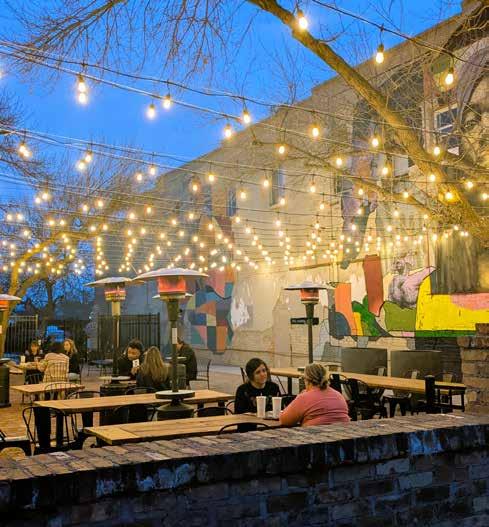


The Bambino boasts a colorful, well-lit patio for summer dining on Midvale’s Historic Main Street. Live music is performed at the pizza shop on most weekends. (Peri Kinder/City Journals)









Hillcrest XC eyes state berth with strong summer workouts, record-breaking track season
Standouts Jonathan Dastrup and Ella Goodman expected to set the pace as Hillcrest competes in 5A this fall.
By Julie Slama j.slama@mycityjournals.com
As July winds down, Hillcrest High’s cross country runners will take to the canyons’ trails, preparing for a competitive season that begins in August.
Head coach Scott Stucki is encouraged by what he’s seen so far this summer.
“Our guys have a chance to be decent; we graduated three, but those guys coming back can be pretty good,” he said. “If we can keep being consistent this summer and keep people healthy, then we have a chance to be the best we've been in a while.”
Now competing at the 5A level, Stucki has confidence in the boys’ team’s ability to qualify and place well at state.
“We’ll be in the realm of possibility (to win region 4 although) we're not the favorites because Taylorsville is the defending state champ. But if our guys develop, we may have a chance to compete for it,” Stucki said. “(Incoming senior) Jonathan Dastrup is going to be our leader on the course. If he stays healthy, he's going to have a good season.”
Dastrup finished fourth for the Huskies at last year’s state meet, helping the team continue its streak of 19 consecutive state appearances. This year’s state meet is scheduled for Oct. 29 at Sugar House Park. Regionals will take place at Valley Regional Park in Taylorsville and divisionals at Lakeside Park in Orem.
While the boys’ team appears poised for a strong season, Stucki expressed uncertainty about the girls’ squad.
“I don't know that we're going to have the depth to challenge for anything. It’s been hard since it’s summer and I haven’t seen all the kids I think who are going to be out, but
(incoming junior) Ella Goodman is going to have a good season. We've got other girls who could be pretty good behind her; we just have to see if we have enough of them,” he said.
Cross country varsity teams consist of seven runners, with the top five counting toward a team score.
Last year, Hillcrest’s girls only qualified two individuals for state, including Goodman, who placed 57th. However, she’s coming off a standout track season, where she broke the school record in the 800 meters (2:22.79) and placed 20th at the state track meet.
Goodman also anchored the school-record-setting 4x800-meter relay team, with teammates and sophomores Tristan Oler, Kate Tuttle and Tavia Wilde, that posted a time of 10:19.4 and finished 15th at state.
In field events, sophomore Coco Collins made her mark with a school record of 117 feet in the discus at regionals. The girls placed fourth overall at region, while the boys took third.
“Coco was one spot out of making finals in both the shot (10th place at 32’ 10”) and discus (10th at 106’ 3”). Overall, our teams’ throws were better this year, especially Coco. She threw marks that would have gotten her a medal easily last year. She threw well this year, especially in discus. She just needed to throw great to get on the podium,” Stucki said.
One of the season’s highlights came in girls’ pole vault, where Hillcrest swept the podium. Sophomore Kallie Doverspike claimed the state title with a vault of 8 feet. Close behind her were teammates sophomore Sarah Lignell (7'6", second), senior Charly Nelson (7'6", third) and junior Lindsay Siavrakas (7', fourth).
Two boys’ school relay records were set.
The 4x800 team—sophomore Greg Anderson, Dastrup and seniors Matt Keller and Josh Martin—clocked in at 8:17.42 to finish ninth at state. Meanwhile, the 4x200 squad of

junior Will Nielson and seniors Lucas Loren, Thomas Harris and Hunter Hanson placed 12th and set a new school best with a time of 1:31.77.
In individual boys’ events, senior Carter Hill took second in the boys’ pole vault with a mark of 11 feet 6 inches. Senior Adam Collins medaled in both the discus (fifth, 141'4") and shot put (sixth, 48'5.5"). Martin finished sixth in the 1600 meters, recording a time of 4:22.39.
“We had more kids qualify for state,
especially by mark, than we had in a while. I was pretty pleased with how well we competed, especially our four boys’ relays; we ran the best we've ran all year,” Stucki said. “Next (track season) we’re competing at 5A so we're going to have to do even better to get those kids back to state. It's going to be tougher; the qualifying marks are harder to get. We'll get some kids in hitting qualifying marks and then we'll get more kids through with region results. Our relays will be competitive and should do well.”l
The Midvale City Journal is a monthly publication distributed directly to residents via the USPS as well as locations throughout Midvale. For information about distribution please email hello@thecityjournals.com or call our offices. Rack locations are also available on our website.
The views and opinions expressed in display advertisements do not necessarily reflect or represent the views and opinions held by Loyal Perch Media or the City Journals. This publication may not be reproduced in whole or in part without the express written consent of the owner. © 2019 Loyal Perch Media, Inc.
PUBLISHER
Bryan Scott | bryan.s@thecityjournals.com
EDITOR
Travis Barton | travis.b@thecityjournals.com
ADVERTISING EXECUTIVES
Mieka Sawatzki | mieka.s@thecityjournals.com
Lindsay Andreasen | lindsay.a@thecityjournals.com
Jason Corbridge | jason.c@thecityjournals.com
Ryan Casper | ryan.c@thecityjournals.com
Marc Davis | marc.d@thecityjournals.com
Lydia Rice | lydia.r@thecityjournals.com 385-557-1022 Rack locations are also available on our website. EDITORIAL &
Anna Pro Ty Gorton Stacey LaMont HOLLADAY

Hillcrest High pole vaulters placed well at the state meet last spring; seen here at practice is Charly Nelson. (Julie Slama/City Journals)
From $300 dreams to
Rainy days can be a food truck’s biggest villain.
By Shaun Delliskave s.delliskave@mycityjournals.com
When Kenneth Hunt rolled into Utah in the summer of 2019, he brought with him a weathered smoker, years of culinary experience and an unwavering Texas pride. Now, six years later, he’s the owner and sole operator of Hunt’s Texas BBQ, a mobile barbecue operation serving slow-cooked brisket and pulled pork to hungry customers across the Salt Lake Valley. But behind the smell of mesquite smoke and the sizzle of meat is a oneman production fueled by grit, consistency and a love for the craft.
“My wife and two kids moved down here from Houston in June of 2019,” Hunt recalled. “After living in the Houston area for 40-plus years, I’ve had my fair share of hurricanes and storms and whatnot…we were just at the point to where we were tired of redoing a house and dealing with floods and everything that came along bad—the chemical plants and everything like that.”
Utah, with its mountain views and considerably less humidity, offered a fresh start.
“I’ve always enjoyed barbecuing for friends and family and coworkers and stuff like that, so I figured I’d take a shot. We bought this trailer, added some pits, and that was 6 years ago. Been going strong since then,” he said.
But “going strong” doesn’t mean it’s easy. Hunt runs the truck solo, managing the entire operation from purchasing to prep to service. His wife, a schoolteacher, is busy during the academic year, leaving Hunt to wear every hat in the business.
“I pretty much do all my shopping and scheduling and whatnot,” he said. “So it gets a little hectic and crazy trying to juggle every hat to wear and still put out some great Texas barbecue.”
The day often begins before sunrise. The raspy voiced entrepreneur still maintains his friendly Texas drawl.
“I start cooking about six in the morning. And of course, these briskets—shoot—they go 10 to 12 hours at least, so nothing’s really served day-of. I’m smoking briskets constantly and pork butts. But with barbecue, there is no exact time. When they’re done, they let you know they’re done.”
That intuition—listening to the meat— comes from experience, not a recipe book. Once cooked, meats are wrapped and refrigerated until serving.
Unlike a brick-and-mortar restaurant, a food truck requires strategy: site scouting, setup and building a customer base from scratch. Hunt wasn’t sure if Utah was going to be a permanent home, so the trailer offered flexibility.
“With the price of real estate for a storefront, you gotta put a big investment into that and really, really, really want to stay here and put down roots. With that being said, it’s a lot
$1,000
realities—barbecue ain’t for the faint of heartburn
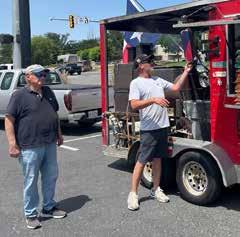
easier to chase the money, per se, with the food truck,” he said.
His livelihood was temporarily derailed as vandals hit his trailer one night. It took several days to get it in operating order.
And chasing the money means learning the terrain. Not every event is a winner.
“I remember my first year or so—if I could go out anywhere and make $300, I thought I was doing something really good,” Hunt said. “Now, six years later, those times have changed drastically.”
He’s learned which locations and partnerships are profitable, and which aren’t. For example, events with the local Food Truck League can be a double-edged sword.
“They’re great for starting out and stuff like that, but they do charge us food trucks 10%,” Hunt explained. “So always having to pay somebody money to do your own stuff is not really the best choice. You go out with 10 different trucks and some days it’s hard to make $1,000—you might only do $300 or $400. And for me, that’s not really sustainable.”
There’s also the logistical gamble of having too much food left over—a cardinal sin in Hunt’s book.
If he does bring anything back, it usually doesn’t excite his family. “After six years, my family really doesn’t care to dine on barbecue for dinner any longer.”
When the weather cooperates, business is better. “The rain is the only thing that'll stop me from serving. Nobody really wants to come out in the rain,” he said. “The snow—there’s no real problem here in Utah with the snow. People are used to it.”
Running the truck isn’t just about cooking—it’s also about customer service. And sometimes, that requires quick triage.
“There’s some people that want to be catered to when they come to you,” Hunt said. “And if there’s 20 people in line, you don’t always have that extra four minutes to sit and chat. Some people might get upset that I have to rush you through the line, but if it’s snowing outside, nobody really wants to wait 40 minutes to get their plate.”
Still, he makes time when he can. “If you


still want to chat when I’m done, more than happy to come outside the trailer and talk to you.”
Some days, he runs the truck five or six days a week. Other weeks, only twice. That’s the balance he tries to strike between work and life.
“My wife is a teacher and she’s off for summer, so there are times that I want to spend a couple days with her. We’ll take a vacation. I might cancel some events just so I can spend more time. Because it’s not always just about work.”
Even after six years, the flame hasn’t gone out.
“I still enjoy doing it,” he said. “I don’t know what else I’d do right now. After six
years of doing this—I still love it.”
You can find Hunt’s Texas BBQ trailer next location on Facebook or Instagram.l

Kenneth Hunt stands between his barbecue smokers and equally large Texas flag. (Shaun Delliskave/City Journals)
Kenneth Hunt checks on his smokers before serving some fresh brisket. (Shaun Delliskave/City Journals)
Kenneth Hunt goes over the menu with a customer. (Shaun Delliskave/City Journals)
Working in the food industry? Look to see if this certification is needed.
By Julie Slama j.slama@mycityjournals.com
Whether aspiring of becoming a sous chef, planning to serve street tacos from a food truck or seeking a part-time restaurant job — one thing is almost always required first: a food handlers permit.
Many states, including Utah, require food service workers to complete food safety training before receiving their permit. This applies to those who prepare, serve or handle food for public consumption from restaurant staff and caterers to food truck operators and others whose roles involve direct contact with food.
In Utah, earning a food handlers permit means completing a 75-minute training course focused on food safety. The course teaches how to prevent food and surface contamination, use proper time and temperature controls to avoid foodborne illnesses, and maintain a clean and sanitary environment for food preparation and service, explained Cassandra Fairclough, program specialist at the Utah Department of Health and Human Services.
“It shows you understand the basics of food safety,” she said. “There are five or six
Before handling food, handle this
things that are very concerning for food protection that can cause illness so those are some of the things taught in the training classes, like handwashing hygiene, cross contamination in food, temperature control — holding at the right temperature for the correct amount of time and those factors.”
Another significant focus is proper chemical usage, said Jeff Oaks, food protection bureau manager for Salt Lake County’s health department.
“There's a component of dishwashing that has to be done,” he said. “You have to learn how you wash dishes in a restaurant because that's different than in your house with a triple sink and not a double sink.”
After the training, participants take a 40-question exam and must score at least 75% to pass. In Salt Lake County, those who pass will receive a temporary permit; the official Utah Food Handlers Permit will be mailed within 30 days. The permit is valid for three years. The course must be retaken for renewal.
Since 2013 the Utah Department of Health has approved third-party agencies to conduct the training, although local health departments can provide training as well and they are responsible for issuing the permits. From July 1, 2023 to June 30, 2024, Salt Lake County Health Department issued 41,240 of the state’s 109,865 food handlers permits.
To find a certified provider, visit the state’s
approved training list: www.epi.utah.gov/ wp-content/uploads/foodHandler_list.pdf. Providers may offer in-person or online options, sometimes in multiple languages. Check to ensure the online courses are compatible with all devices and operating systems.
The base cost of the training is $15, though agencies may include additional processing or administrative fees. In some cases, employers may cover the cost or offer group discounts.
Additional licenses, permits or certifications may be required for specific roles — such as serving alcohol, being a food manager, running a food truck or operating a booth at a farmers market.
“Different agencies will have requirements,” Oaks said. “In Salt Lake County, all restaurant workers have a food handlers permit, but for example, there are companies that package produce locally, like a bag of carrots or lettuce, and they are regulated by the state’s agriculture and food department. But within their facilities, they require food handlers permits or some other certification. Some companies may say, we still want you to get a food handlers permit. We have almost 5,500 restaurants (and others that serve food) so all their employees either have managers’ certificates or food handlers permits. Usually, the grocery store employees have food handlers permits if they're working in the deli or the butcher shop or the produce, where they're cutting and doing food prepara-
tion and established concessioners such as the (University of Utah) Utes or Utah Jazz have food handlers permits.”
“It’s best to check with your local health department to get specific conditions and information on the type of food service that is being provided so they can help people learn what is required,” Fairclough said.
She said the food handlers training and certification program is regularly reviewed by state officials, local health departments and industry professionals to ensure it aligns with the latest (2022) version of the FDA Food Code, along with Utah-specific amendments. The Food Code is designed to protect public health and provide a standardized approach to food safety across various service environments.
Oaks, who has taught food handlers permit classes, said he had parents who would bring their kids to get a food handlers permit.
“It’s good knowledge and they wanted their kids to know; it had nothing to do with employment,” he said. “If you want to up your game for food safety, food preparation or food serving at home or wherever you might be, it's not a bad idea to get it. Not all states require a food handlers permit, but I’m glad Utah does. I'm glad our legislature and our state health department see the value in it, so there's at least a minimum standard for food workers.” l
Savor the finer things at a La Caille wine and cheese tasting
With its lush gardens and château vibes, La Caille makes every tasting feel like a mini French vacation.
By Peri Kinder peri.k@thecityjournals.com
Imaginesitting in a French château on a warm summer evening, surrounded by beautiful gardens and a majestic mountain view. You’re sampling exquisite wines and delightful cheeses, taking the time to sip, savor and enjoy the moment.
That dream can be a reality when you attend one of La Caille’s popular wine tastings. If you have a deep appreciation for wine, or maybe you’re a curious beginner, the tastings offer a mix of education and indulgence.
Angela Eltzholtz is La Caille’s wine specialist. She fell in love with wine during the time she spent working at a winery in Temecula, California. Eltzholtz's favorite thing is introducing people to the wines at La Caille which include two estate wines made with grapes grown, picked fresh, fermented and bottled at La Caille.
“People are very surprised to find out we have a vineyard here and we produce a great product,” she said. “We have the Seyval Blanc and our beloved Dornfelder grapes. Those are the two varietals that we grow.”
La Caille’s estate Enchante wine is defined as “Liquid sunshine in a glass.” It carries the aromas of melon, honeysuckle and subtle florals, with a palate of citrus flavors. The estate Château Rosé features a blend of the vineyard's

grapes, with the flavors of blueberry, strawberry and a dash of spice.
Three red wines are also produced at La Caille, using juice from other wineries, but aged, blended and bottled on site. The Napa Valley Cabernet Sauvignon, the Russian River Valley Pinot Noir and the Choix Evident are all bottled under the Château La Caille label.
“I’m a seasonal wine drinker, so right now I’m loving the estate rosé because that’s just what goes with the season,” Eltzholtz said. “I love it because it’s ours. We make it 100%. I love drinking a wine where I see the grapes grow throughout the year.”
The tasting features five La Caille wines, paired with Caputo’s cheeses, including Laura Channel goat cheese, blue
and fig mostarda, and tartufo.
Wine and cheese tastings are held every Wednesday and Friday at 6 p.m., and Saturdays at 4 p.m. Seats must be reserved and only those 21 and older can attend. The cost is $29 for wine, plus $16 for the cheese pairing experience. Each attendee also receives a souvenir wine glass. To register for a wine tasting, or to order wine for pick-up from the estate, visit LaCaille.com. The wines are not available at the liquor store or in other restaurants.
“The experience lasts 60 to 75 minutes but since everybody is always welcome to have a glass of wine after the tasting, sometimes that takes a little longer,” she said. “They’ll hang out and enjoy their favorite wine and go out on the patio.”
Located near the mouth of Little Cottonwood Canyon at 9565 Wasatch Blvd., La Caille is celebrating 50 years of fine dining and magical experiences. While the restaurant offers upscale elegance, the wine tastings can be a more casual affair.
“I talk to them about the wine, the cheese and La Caille. We often walk outside and see the peacocks,” Eltzholtz said. “The wine tasting brings them in but everybody’s so interested in this property, its history about what we do here. So we talk a lot about that, too.
“People will enjoy it wherever they are, from beginners who don’t know anything about wine, to people who already know a lot about wine. So really, I have the full spectrum. I will meet you, where you’re at.”
Wine and cheese tastings at La Caille include five wines under the Château La Caille label, plus cheeses from Caputo’s. (Photo courtesy of La Caille)
Savor the last days of summer with local foods and festivals
Eat up everything summer has to offer with festivals and events celebrating beloved local ingredients, rich cultural cuisine and skilled culinary artisans.
By Jet Burnham j.burnham@mycityjournals.com
Indian
Food Fair
Aug. 2, 11 a.m.-8 p.m. at Liberty Park
Spice up your summer with the fragrant flavors of Indian cuisine featured at the sixth annual Indian Food Fair. Enjoy authentic food, music, dance and culture.
Festival Gastronomico Mexicano
Aug. 2, 4-9 p.m. at Centro Civico Mexicano, 155 S. 600 West
Utah’s first Mexican Food Festival will feature authentic dishes, drinks and desserts highlighting the culinary diversity of the several regions of Mexico. Local restaurants, food trucks and traditional cooks and chefs will showcase the traditional and contemporary dishes that celebrate Mexico’s culinary cultural heritage.
Bear Lake Raspberry Days
Aug. 7-9 in Garden City
Bear Lake Raspberry Days celebrates all things raspberry to eat, drink and buy. Come for the famous Bear Lake raspberry shakes and stay for the nighttime Boat Light Parade and fireworks. The three-day celebration includes the traditional Main Street parade, boat parade, craft fair, carnival rides, group Zumba, live music, rodeo and fireworks. Dive into the fruity fun of the raspberry pie eating contest or delight in the razzle dazzle of the talent show. Compete for prizes and bragging rights by joining the kid’s fishing tournament, 5K fun run, golf scramble or cornhole and pickleball tournaments.
Lemon Bash
Aug. 15, 4-9 p.m. at Ken Garff University Club at Rice Eccles Stadium
This sweet event turns lemons into
lemonade by raising money for childhood cancer research through Alex’s Lemonade Stand Foundation. Cool down with refreshing lemonade and appetizers provided with free admission. Step into the casino room, place a bid at the silent auction or enjoy family-friendly activities and access to the field.
2025 Utah Cheese Awards Tasting Reception and Medal Ceremony
Aug. 24, 2-5 p.m. at 2Row Brewing in Midvale
A buffet of locally made cheese, fruit, honey, hot sauce, sweet sauce and more will celebrate this year’s top Utah cheesemakers and makers of cheese plate foods. Tickets to taste the buffet of the winners’ wares are $20, online or at the door.
Payson City Golden Onion Days
Aug. 29-Sept.1 in Payson
For 96 years, the people of Payson have celebrated their agricultural heritage with an onion festival. The many layers of the event offer something for every interest including a historic children’s parade, soap box derby, baby contest, talent show and car show. Residents compete for the prize of the biggest homegrown onions at the art and flower show. And, of course, there are food vendors selling onions of the “bloomin’ onion” variety to hungry festivalgoers.
Hooper Tomato Days
Aug. 30-Sept. 1 in Hooper
Hooper Tomato Days is bursting with tomato-town charm and themed activities such as the 5K Tomato Chase, Cherry Tomato Baby Show and Miss Pink Tomato pageant. With all the fixings of a traditional community spirit festival—barbecue competition, pancake breakfast, rodeo, live music, parade and fireworks—this year will honor its milestone 100th year by including features from the earliest years of the event such as a traveling band riding around town to rouse residents for the first day of the festival. The event also features unique smalltown sport with its dog race, cow drop contest, kids sawdust scramble and trash fishing.

Salt Lake Greek Festival
Sept 5-7, Friday and Saturday 11 a.m.10 p.m., Sunday noon to 8 p.m.
Journey to the land of rich food, lively music and charming culture at the 49th annual Greek Festival. Sweet and savory Greek delicacies and traditional bouzouki music are as close as the north parking lot of Holy Trinity Cathedral at 279 S. 300 West in SLC.
11th annual Eat Drink SLC
Sept. 10 and 11, 5-8 p.m. at Tracy Aviary
Enjoy an elevated culinary experience sampling food and drink from locally owned restaurants, craft breweries and artisan purveyors while enjoying live music and dance performances.
SLC VegFest
Sept. 13, 12-8 p.m. at Library Square
Sample vegan dishes from local restaurants or discover your new favorite vegan baked goods at the ninth annual SLC VegFest. This local celebration of veganism and plant-based eating is family friendly, with a kids area and live music. An adults-only beer garden features all vegan varieties.
Festa Italiana
Sept. 13 and 14, Saturday 11 a.m.10 p.m., Sunday 11 a.m.-7 p.m. at The
Gateway Plaza
Slurp, swallow and savor a variety of region-based Italian cuisines, beer and wine as proud Italian-Americans celebrate their roots. Watch cooking demos and explore arts and crafts booths, or compete in the pizza or pasta eating contests. Learn about Italian culture through historical displays, live music, street performers, vintage bike show and exotic Italian car displays.
Brigham City Peach Days
Sept. 19 and 20 in Brigham City
Have a peachy keen time celebrating with a community proud of its produce. Peaches are the highlight of the event but the two days of festivities also include music concerts, car show, Harley and Custom Bike Show, quilt show and two different parades. Don’t miss the Brigham’s Beard Competition with categories for best mustache, best goatee, longest beard and best peach fuzz.
Melon Days Festival
Sept. 19 and 20 in Green River
For 119 years, Green River has celebrated their famously tasty melons and their growers with a parade and craft fair. Enjoy a slice of smalltown enthusiasm for melons at this year’s breakfast in the park, melon carving, photo contest, pony/unicorn rides, softball tournament, Fun Shoot, Melon Run, junior entrepreneur market and golf scramble. l

Watermelons are featured prominently in the annual Melon Days parade. (Photo courtesy Robin Hunt)
A bold new partnership: Midvale aligns with statewide equity initiative
Midvale signs on as the first city in Salt Lake County to pass an official resolution of support.
By Peri Kinder peri.k@thecityjournals.com
Midvale is the first city in Salt Lake County, and only the second city in the state, to pass a resolution supporting A Bolder Way Forward and its dedication to helping women and girls flourish. The mayor and city council formalized support for the initiative in June, with a promise to identify resources and strategies that support the community and align with the statewide movement.
“We at Midvale City are already doing a lot of this work,” said Mayor Dustin Gettel. “There’s still a lot of work to be done. Being the first in Salt Lake County to do it, that’s exciting, but being able to actually do the work now and get this designation is much more important.”
Statistics from the Utah Women & Leadership Project show that 1 in 3 Utah women will experience domestic violence in her lifetime, only 12% of Utah families can afford infant care and Utah has one of the highest gender wage gaps in the country.
Utah continues to have high levels of sexual assault and gender-based discrimination while ranking as one of the worst states
for women’s equality. It also has low levels of women’s leadership in business and politics.
Gettel noted that Midvale has been represented by strong women, including JoAnn Seghini, who served two decades as Midvale mayor and three terms as city council member. He also mentioned that April Morse serves as Midvale’s police chief and that seven years ago, no women were elected to the city council, but now three women serve as council members.
“As I sit around the table for our senior staff meetings, it’s obvious that we have a great mix of men and women at that table, as it should be,” Gettel said. “I want to make sure we recognize the wonderful women who have led Midvale, past, present and future.”
Through collaborations with local governments, A Bolder Way Forward hopes to champion change and meaningful progress. Mariah Hill works as Midvale’s administrative services director as well as serving as co-lead for the local government committee of A Bolder Way Forward.
She said in order to move the needle in some of those areas where Utah is lacking, government, business and community leaders need to come together to bring about significant change by 2030.
“If we did nothing, then it could take 30 to 40 years to see change. Instead, we’re trying to do that in five to seven years,” Hill said. “Research continues to show that women and
girls are not thriving in critical areas in Utah.”
The adopted resolution acknowledged that women face serious challenges and consistent disparities in wages and leadership representation. It also states that Midvale recognizes the importance of encouraging the mission of A Bolder Way Forward to strengthen women and girls in Utah.
Midvale committed to using data-driven approaches, consulting academic research, policy briefs, and community surveys to guide its efforts and measure progress in supporting the initiative. The resolution points to Midvale City’s policies that have already demonstrated support for women in the workforce, including progressive family leave policies and paid maternity and caregiver leave.
The proclamation reads, “Midvale City recognizes that when women and girls experience good health and well-being, the freedom of safety and security, equal representation in the community, access and opportunity for education, and successful employment in fair and equitable workplaces, all Utahns thrive.”
North Salt Lake was the first city in Utah to collaborate with A Bolder Way Forward. For more information about the initiative, visit usu. edu/uwlp/a-bolder-way-forward/overview.
“It is definitely something that I think Midvale is uniquely positioned to lead the way on, and that excites me as mayor,” Gettel said. “I think it’s going to be a great thing and can’t wait to see what’s next.” l


Midvale Mayor Dustin Gettel (center) and City Council members passed a resolution to support A Bolder Way Forward, an initiative to create more opportunities, better outcomes and safer environments for women and girls. Clockwise from left, Midvale City Councilmember Denece Mikolash, Midvale Administrative Services Director Mariah Hill, City Councilmembers Bonnie Billings, Paul Glover, Bryant Brown and Heidi Robinson, Utah Women & Leadership Project Local Outreach Deborah Lin and Salt Lake County Councilmember Laurie Stringham. (Photo courtesy of Midvale)
When the cafeteria closes: The harsh reality of summer hunger for kids
By Lizzie Walje l.walje@mycityjournals.com
The Utah Food Bank has historically dubbed summer as the official season of hunger. To some, this might come as a surprise. However, when schools shut down for the summer, so do breakfast and lunch programs, which students often rely on to ensure they’re receiving meals throughout the day.
According to Feeding America, the country’s largest nonprofit organization dedicated to combatting hunger, one in five children in the United States are currently facing food insecurity. In Utah specifically, the ratio is one out of eight people for adults, and one out of six for children. In Utah alone, roughly 220,000 kids rely on school lunch and breakfast programs for their daily nutrition.
The effects of hunger have long been studied and documented, showcasing that regardless of age, missing even one meal can result in a slew of negative consequences, both chronic and acute. Feeding America explains why food insecurity is particularly dangerous for our youngest residents:
“For children, food insecurity is particularly devastating. Not having enough healthy food can have serious implications for a child’s physical and mental health, academic achievement and future economic prosperity. Research shows an association between food insecurity and delayed development in young children; risk of chronic illnesses like asthma and anemia; and behavioral problems like eating disorders, hyperactivity, anxiety and aggression in school-age children.”
Who you are can also have bearing on
your potential to face food insecurity. While food insecurity is an issue that effects people of all backgrounds and circumstances, Black and Latino children are twice as likely to face hunger compared to their white counterparts. Another common risk factor for childhood food insecurity is growing up in a single parent household. In 2022, children who lived in a single income household, typically led by single mothers, were 33% more likely to experience hunger.
Historically speaking, summer is always a difficult season for reconciling hunger. However, 2025 has presented new challenges, especially following budget cuts implemented by the U.S. Department of Agriculture. Back in March of this year, two federal programs were cut, resulting in a combined loss of nearly $1 billion in funding for schools and food banks to buy directly from local farms, ranchers and producers. At the time, the agency claimed it was a decision that would help “return [the agency] to long-term, fiscally responsible initiatives.”
The decision was made by the Trump Administration and Elon Musk’s Department of Government Efficiency or DOGE. At the time, they claimed the decision to cut funding was a means to slash federal spending, and therefore, reduce government waste. Previously, the USDA programs in question were funded through the agency's Commodity Credit Corporation, a Depression-era fund created to buy products directly from farmers. The cuts resulted in a loss of about $660 million in funding this year for the Local Food for Schools program, which is active in 40 U.S. states, including Utah.
Despite the jarring budget cuts, the Utah Food Bank sprang into action, as they are accustomed to doing ahead of the summer months. Back in March, they held an event
Survey seeks questions readers have for their local government candidates
Fill out our survey so your candidates know what questions to answer for our Voter Guide.
Welcome to the City Journals survey!
We're happy to have you here and for the opportunity to learn about how our newspapers are being utilized in our communities.
In the October issues of our newspapers, we will publish a Voters' Guide to provide readers with information about the candidates listed on each municipal ballot.
We understand how voters can visit many different resources and websites and end up looking at the same information—if not the exact same wording or candidate platforms. We hope to provide readers with the information they want to know about each candidate. Take a moment to consider what information ultimately makes or
called Feed Utah which was lauded for its convenience. Ahead of the event, pamphlets were left on residents’ front doors which explained how they could participate by either gifting a financial donation or leaving a bag of nonperishable food on their doorstep, which would then be picked up by Food Bank volunteers and employees.
“So it’s really hard for families who have a fixed budget to have money left for food. Do they choose to pay the rent? Do they choose to pay the power bill so they have heat?” said Utah Food Bank CEO and President Ginette Bott. “We recognize that not everyone can [donate] at this time. But at some point, in the future, please help us, or your neighbors.”
After the success of the Feed Utah event, it was time again for the food bank to start tackling its most critical season: summer. Preparations for summer often begin as early as Thanksgiving and Christmas of the prior year, and with the added stress of federal budget cuts looming, it was imperative to get a handful of programs and events on the docket.
Incidentally, the USDA will still be providing funds for the Utah Food Bank’s Summer Food Service Program (SFSP). This program expands upon the food bank’s Kid’s Café program, which focuses on bringing meals to children 18 and under during the summer months. The program runs through Aug. 8 and includes two means of operation. Children can either
go to an open site, where anyone under 18 will receive a meal, or they can access a closed enrolled site if they’re participating in specific activities.
Each site will offer either individual daily meals or a weekly box containing seven breakfasts and seven lunches. Meal types and schedules vary by location, but all sites will be closed June 16, July 4 and July 24 in observation of state and federal holidays.
To find a meal site near you, visit www.UtahFoodBank.org/SummerMeals, text “SUMMER” to 914-342-7744, or call the USDA National Hunger Hotline at 1-866-3-HUNGRY. More than 300 sites are available statewide, with Utah Food Bank operating 60 of them. Children must be present to receive a meal.
Another helpful program children can utilize this summer is SUN bucks or summer EBT. Eligible families will receive a $120 credit for each school-aged child in the household. To learn all about the SUN bucks program, who qualifies, how to apply, and more, visit www. jobs.utah.gov/customereducation/services/sebt/ index.
For adults in need of food assistance, the Utah Food Bank is a great place to start locating resources. Visit www.utahfoodbank.org/ get-help/. This link can also be used by adults who are wishing to donate or volunteer at the food bank. l
breaks your decision to vote for a specific individual in our local elections.
“It’s important to have candidates answer the actual questions their constituents would ask them,” said City Journals Creative Director Bryan Scott. “This is your chance to do that.”

Scan this QR code to fill out the short survey.
Please respond to the survey found through the QR code, which will take less than three minutes to complete. Your response will help guide the design of our Voters’ Guide.
The “submit” button must be clicked before Monday, Aug. 18 (at 11:59 p.m.).
Thank you for your continued readership and support of your local staff here at the City Journals. l


















Spoil your pet at these top 5 dog bakeries
From gourmet biscuits to birthday pizzas, local dog bakeries serve up tail-wagging treats.
By Peri Kinder peri.k@thecityjournals.com
Dogbakeries are popping up all over, catering to man’s best friend. If you’re looking for something as simple as a healthy, organic treat or as elaborate as a birthday cake for your furry friend, these local bakeries will help show your fourlegged bestie how much you love them.
Dela’s Doggy Desserts, 1538 W. 7800 South (West Jordan)
Your canine companion will love the selection of yummy treats at Dela’s Doggy Desserts. The problem is, you’ll want to buy them all! The Doggy S’more features a peanut butter and pumpkin cookie with carob and yogurt topping. Or try the Doggy Donut Pack with four doughnuts made from sweet potato and oats, topped with cream cheese, peanut butter and carob.
Dela’s also offers a unique outdoor space, which includes a grass play area and a covered patio, to host your pup’s birthday or other special occasion. The shop’s pet boutique sells adorable collars, leashes, bandanas, food bowls and accessories. Plus, there are fun gifts for dog parents including picture frames, key chains and glasses. Visit online at DelasDoggyDesserts.com.
Rebel Paw, 7681 S. Main St. (Midvale)
The popular dog food truck has found a permanent home on Midvale’s Historic Main Street, where pups and their owners can browse for the perfect treat or toy. The bakery features healthy dog-friendly snacks like cupcakes, cinnamon rolls, peanut butter sandwich cookies, dog pies and more. Rebel Paws
makes elaborate cakes in an assortment of designs for adoption day celebrations or any other event.
Pup parents can also customize a bandana, choosing from a variety of fabrics, sizes, colors and patterns. If you’re hosting a dog party, the Rebel Paw food truck is available to book so your puppy and all his friends can enjoy delicious treats. For more information, visit RebelPaw801.com.
Ma & Paws Bakery, 1227 E. 3300 South (Millcreek)
Featuring natural, holistic, organic foods, Ma & Paws Bakery hopes to alleviate many problems affecting pets, including allergies, joint issues, digestive ailments and kidney troubles. The bakery has 20 different flavors of gourmet dog biscuits in four biscuit sizes to suit any dog. One of the bakery’s best-selling items is the custom-made birthday pizza that includes whole wheat dough, tomato sauce, shredded chicken and parmesan cheese.
Ma & Paws also has an assortment of natural dog foods, vitamins, supplements, toys, collars and chews. For bath days, use the self-serve dog wash for less than $20 or give Fido a Theraclean Dogbubbles bath that deep-cleans her fur. Visit MaAndPawsBakeryInc.com for more info.
Jake’s Bakes Dog Treats (Online)
Kerri Cooper creates fun and original pup snacks with superfoods like pumpkin, turmeric, sweet potato, oats, hemp hearts, flax seeds and blueberries. Doggy favorites include the Bacon & Cheddar Woofles with eggs, the canine cannoli featuring Greek yogurt and cinnamon and Pup Tarts in strawberry or blueberry.
Jake’s Bakes is an online-only shop but Cooper frequently attends farmers markets in Salt Lake, Weber and Davis County,



where her fans can pick up a bag of treats for their furry friends. Follow her Instagram page @JakesBakesTreats for her summer schedule. For a complete list of treats, snacks and chews, visit JakesBakesLLC.com.
The Dog’s Meow, 2047 E. 3300 South (Millcreek), 866 E 12300 S. (Draper)
The winner of several Best of State awards, The Dog’s Meow has been operating for nearly 30 years. Now, with two locations, the shop is a pioneer in the healthy dog and cat food industry, bringing quality products to furry friends across the state.
The Dog’s Meow only carries the highest quality products, so customers know the food, treats, supplements and toppers they buy will support their pets’ healthy growth. Pet owners can also purchase safe toys, dental and grooming products, biodegradable poop bags and more. Plus, the DIY dog wash stations help keep puppies clean for an affordable price. Learn more at DogsMeow.com. l
When minutes count, count on
to know us before you need
When you need emergency care fast, the closest emergency room is a smart thing to know. You never know the level of care you’ll need when an emergency happens and choosing the right ER can make all the difference. And a hospital ER comes with the confidence of additional services right on-site.
CommonSpirit Holy Cross Hospital – Salt Lake has been awarded Chest Pain Center Accreditation from the American College of Cardiology (ACC). Facilities that achieve accreditation meet or exceed an array of stringent criteria for evaluating, diagnosing and treating patients who may be experiencing a heart attack.
Find emergency care close to you at mountain.commonspirit.org.
(TTY: 711).
Show your sweet pup some love with homemade treats, healthy foods and fun cakes from dog bakeries in the area. (Canva stock)



MIDVALE CITY DIRECTORY
City Hall
801-567-7200
Finance/Utilities 801-567-7200
Court 801-567-7265
City Attorney’s O ce ......................... 801-567-7250
City Recorder/Human Resources ... 801-567-7228
Community Development ............... 801-567-7211
Public Works 801-567-7235
Ace Disposal/Recycling 801-363-9995
Midvale Historical Museum 801-567-7285
Midvale Senior Center 385-468-3350
SL County Animal Services 385-468-7387
Communications 801-567-7230
MIDVALE CITY ELECTED OFFICIALS
Mayor - Dustin Gettel
Email: dgettel@midvaleut.gov
CITY COUNCIL
District 1 - Bonnie Billings
Email: bbillings@midvaleut.gov
District 2 - Paul Glover
Email: pglover@midvaleut.gov
District 3 - Heidi Robinson
Email: Hrobinson@midvaleut.gov
District 4 - Bryant Brown
Email: bbrown@midvaleut.gov
District 5 - Denece Mikolash
Email: Dmikolash@midvaleut.gov
WHO TO CALL FOR…
Water Bills
801-567-7200
Ordering A New Trash Can 801-567-7202
Permits 801-567-7213
Court 801-567-7265
Paying For Tra c School 801-567-7202
Business Licensing 801-567-7214
Cemetery 801-567-7235
Planning and Zoning 801-567-7231
Code Enforcement .............................. 801-567-7208
Building inspections ........................... 801-567-7213
Graffiti 385-468-9769
PUBLIC SAFETY & EMERGENCY CONTACTS
EMERGENCY 911
UFA Fire/UPD Police
> Non-emergency .............................. 801-840-4000
Uni ed Police Department
> Midvale Precinct 385-468-9350
Public Works
In The Middle of Everything


Midvale Monthly with Mayor Gettel
801-567-7235
Rocky Mountain Power 877-508-5088
Investing in Public Safety: A Smarter Way Forward
Nothing matters more than feeling safe in your own city.
Whether it’s picking up your kids from school, opening your business in the morning, or enjoying a quiet evening walk, peace of mind is something we all value. And lately, I’ve heard more people talking about it. Residents want to feel reassured. They want to know public safety is a top priority, and they deserve to know how we’re responding.
That’s why we are proposing the creation of a dedicated Public Safety Fund, a smarter, more transparent way to support the services that protect Midvale every single day.
Why Now?
The way we’ve traditionally funded public safety, through the general city budget, has worked. But it’s not built for long-term stability. Costs increase, service demands shift, and our ability to plan ahead becomes more challenging.


By creating a dedicated fund, we ensure essential services like police, animal services, and emergency management are protected from year-to-year budget pressures. This fund locks in funding for public safety, period.
What It Means for You
To make this work, we’re proposing a small property tax increase. For the average Midvale homeowner, it amounts to about $5.62 a month, less than what most of us spend on streaming services.
The good news? 94% of the Public Safety Fund will be covered by money we already spend. The proposed increase simply lls the remaining gap so we can keep services strong and responsive.
This isn’t about growing government. It’s about sustaining the core services we all depend on.
Transparency You Can See
This summer, when you receive your Property Valuation Notice from Salt Lake County, you’ll see a new line called “Midvale City Public Safety.” That’s the dedicated fund in action. That’s us being clear and upfront about where your money is going.
You’ll always know how much is going into public safety, and where it’s being spent.
Join the Conversation
We’ll host a Truth in Taxation public hearing on Tuesday, August 19 at 6:00 p.m. at Midvale City Hall. I encourage you to come, ask questions, and learn more about how this proposal impacts you and your neighborhood. Can’t attend in person? You can watch online and submit comments virtually.
Why I Support This

Midvale is a strong, proud city, and our approach to public safety should re ect that. This is our chance to invest in peace of mind, without surprises or uncertainty.
Stagg Street Overhaul Set to Boost Safety, Access and Growth
Main Street is not the only one getting a makeover.


I didn’t run for mayor to play it safe. I ran to make smart, sustainable investments that re ect Midvale’s values. I’ve always said that safety belongs to everyone. Every neighborhood. Every family. Every individual.
Midvale deserves a public safety system that keeps pace with our community. This new fund ensures we have the tools, people, and planning in place to meet today’s needs, and tomorrow’s.
The Quick Facts
• Estimated cost to the average homeowner: $67.38/year
• Average business impact: $122.50/year
• New revenue generated: $940,561—all used exclusively for public safety
• Dedicated Fund = Greater Accountability + Long-Term Stability
Just west of Main are Stagg, Depot and Smelter. As Main and the shops and apartments grow in popularity and population, we need better roads, sidewalks and upgraded utilities.
Starting fall 2025, Midvale City will start:
• Demolition & disposal of existing asphalt, curb, gutter & sidewalk
• Upgrades and expansions to the water and sewer lines
• Installation of improved storm water drainage
• Improvements to power poles and lines
• Installation of new asphalt, curb, gutter and sidewalk
• Construction will begin at the north end of Stagg and crews will work their way toward the south end.
• Once nished, you will be able to enjoy:
• More entrance points to Main Street and parking
• Easier walkability along Stagg, Depot and Smelter
The upgraded water and sewer lines won’t have a noticeable impact but will allow for further growth as Main Street improves.
(Note: Parking spaces will remain the same for businesses and residents along these streets once construction is complete.)
“There might be some interruptions day to day,” Kate Andrus, Midvale’s Redevelopment Agency Program Manager, said. “But we’re going to try to make it as painless as possible.”
City and construction liaisons will reach out to residents and businesses in the a ected areas. We plan to make the process as seamless as possible, and that no one will ever go without power or water.
If you have questions or concerns, please contact us at Midvale City: 801-567-7200 or rda@midvaleut.gov.


In The Middle of Everything
Meet the Midvale Main Art House Artists: Adrianne Freeman
Adrianne Freeman joins Ash Amos and Telli Sommers at the Midvale Main Art House on Main Street. Freeman’s path to full-time artist wasn’t a straight one, but it was bordered with creativity.
“My goal was always to do art full-time,” Freeman said. But life always got in the way.
Freeman, like many artists, grew up crafting with her mother and took all the high school courses in art she could. After graduation, she found herself with her mother and four siblings in a two-bedroom apartment—her father had burned the house down. As the oldest, that threw her into adulthood immediately.

“Right after that, my brother was diagnosed with leukemia,” Freeman reflected. “A few months after that my sister was diagnosed with ovarian cancer. It was a lot.”
She spent most of her time in hospitals, getting her siblings to school and making sure everyone had something to eat. “I got really good at taking care of myself,” she said. That self-care was feeding and nurturing creativity.
After her siblings healed, she worked her way through life, as a nanny and a life coach, as a dental hygienist to a laboratory manager. All these experiences grew her skills in different ways, preparing her for life as an artist. As a nanny, she explored handson crafting with the kids; as a hygienist, she
shaped temporary crowns for patients. Early this year, she found herself with enough put by to immerse herself in art entirely.
Now she is able to cultivate and share her creations. You can find her on Main Street, working on Pysanky Ukrainian egg dyeing, painting with watercolors and acrylics, or making cardboard or toilet paper pulp into miniature elements to add texture and depth to her pieces.
Soon, she hopes to invite others to join her in quiet reflection and creative play—to meditate, craft their own collage boards, and support one another in reaching their goals.
“I want people to feel like their dreams are possible,” Freeman said thoughtfully, “Even if it’s just fantasy land, it does exist somewhere. There is a lot of magic on this planet. I like to capture it with a thought or on paper.”
Freeman’s journey is a testament to resilience, imagination, and the long, winding path creativity often takes. At the Midvale Main Art House, she not only brings her own vision to life but opens the door for others to do the same.
You can find Adrienne on Instagram @ adriannefreeman or stop by the Midvale Main Art House, 7697 S Main Street. She’s there Tuesday through Thursday from 5:00 p.m. to 8:00 p.m., and Saturdays from 2:00 p.m. to 7:00 p.m.
Meet Katie Thorne — Community Development Executive Assistant
Business safety, home construction, or the future growth of the city all pass by Katie Thorne’s desk at Midvale City. As Executive Assistant in the Community Development Department, Thorne supports everything from business licensing and code compliance to economic development and city planning.
Thorne has worked her way up through the City since 2020, starting as a Water Operator I in Public Works. She then served in several key administrative roles in Community Development, first in business licensing, then building permits, before stepping into her current position as Community Development Executive Assistant in June 2025. Her path through the ranks gives her a well-rounded understanding of how different parts of the City work together to serve residents.
It takes many employees and departments to make the City run smoothly, and Thorne is often the one making sure the details don’t get left behind.
“I make sure our licensing and building permit processes are going as smoothly and effectively as possible,” Thorne said. This includes all resident questions when it comes to code, safety, business permits, or construction.
“I am the person that people go to when they have questions about the work that’s happening in the city,” Thorne said.
Thorne is the one who…
• Coordinates with inspectors to keep business licenses up to date.
• Reimburses mural festival artists for their paint.
• Supports safety and code enforcement.
“Katie is an incredible resource to the department,” Adam Olsen, Community Development Director said. “Whether it is an evening or weekend, she can be counted on to help address immediate issues.”
Why does the city need to inspect your space?
“We want to make sure your new electrical isn’t going to catch your house on fire,” Thorne explained.

What about fees? Why does the city need you to pay for licensing and inspection? “We’re not making millions off fees,” Thorne chuckles. “It pays for time and labor.”
The office phone is always open for questions. She encourages residents to “call us” if you “have concerns about the work that’s being done to your home”.
“We’re not the bad guys,” she reiterates. “We are here to be the residents’ biggest resource for assistance.”


AUGUST 2025 CITY NEWSLETTER
MIDVALE. UTAH. GOV
Lost & Found Pets: Where to Begin
If your pet escapes from your yard, bolts out the front door, or goes missing while you’re on vacation, here’s where to start looking and posting.
What to do if your pet is lost: Visit Shelters: Visit your local shelter and surrounding shelters within 24 hours and keep returning. All lost pets that come into Salt Lake County Animal Services are listed at www.adoptutahpets.org. Call Dispatch to report your missing pet at 801-840-4000.
Use social media and yers: Post your pet’s photo on social media platforms like the Next Door App, KSL, and Utah’s Lost & Found Pet Facebook page.
Search Actively: Look for your pet during the day and at night. Call for your pet and stay in one place long enough for them to respond. Organize a search party and go door to door with lost pet yers in the neighborhood where your pet went missing. Place your lost pet yers on public bulletin boards. DON’T GIVE UP!
Steps to take if you nd a lost pet: Report the Pet: Lost pets must be reported to local animal control within 24 hours. It’s the
law, and a shelter is the FIRST place most pet owners look for their missing pet.
Take the Pet to a Shelter: If you nd the pet in Salt Lake County Animal Services jurisdiction, take it directly to the shelter at 511 W. 3900 S. during business hours (10 AM – 6 PM, Tues-Sat). If it’s outside of business hours, call animal control dispatch at 801-840-4000. Salt Lake County Animal Control operates 24/7.
Post Online: Take a picture of the pet and post it on social media (e.g., Facebook, Next Door App, KSL) with details of where you found the animal and that you took it to Salt Lake County Animal Services.
Consider Fostering: Inquire about our Dog & Cat Foster Finder Program.
Prepare yourself before your pet gets lost: ID Tags and Microchips: Ensure your pets have current ID tags and their microchip information is up to date. All pets in Salt Lake County can receive a free microchip at Salt Lake County Animal Services at 511 W 3900 S. For questions, email animal@saltlakecounty.gov.





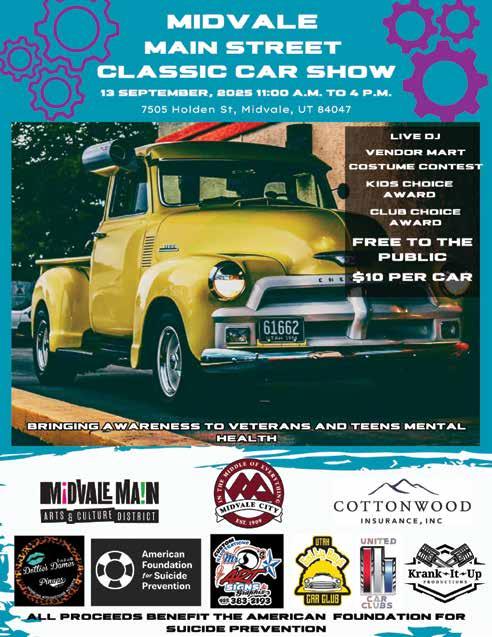
Tips and tricks for lunch remix
Help for parents looking for healthy and fun school lunch ideas.
By Jet Burnham j.burnham@mycityjournals.com
Ultra-processed foods, sugar and synthetic food dyes are the latest antitheses of healthy childhood nutrition. The USDA has called for changes to school breakfast and lunch menus that limit sugars and utilize locally sourced products. And the Utah Legislature just passed a bill to ban synthetic dyes and certain additives in foods served in Utah schools.
“There's definitely a big trend moving towards the more natural side of things, or trying to move away from that processed food and the artificial dyes,” Sharon Turner, a certified nutritionist, said.
Healthy food not only fuels kids’ physical development but it also boosts their ability to learn, said Turner, who works at the Utah State Board of Education.
“Students need to show up nourished and healthy to learn and perform their best, so it's important that they're getting a good breakfast and a good lunch, and they're able to pay attention in class and socialize and get the full benefit of their educational experience,” she said.
Keeping track of what kids should and shouldn’t be eating can leave parents feeling overwhelmed and unsure about what to pack in school lunches. Turner suggests three tips to
ensure kids have healthy, appealing and safe food to fuel their learning as they head back to school.
1. Pack a variety. Kids should eat an assortment of foods from wholesome food groups—fruits for fiber, carbs and natural sugars, and vegetables for nutrients such as iron, beta carotene and antioxidants. Whole grains and proteins complete the meal.
Try this: Charcuterie boards are a healthier reinterpretation of the Kraft Heinz Lunchables, which have always been popular with kids. Create your own by mixing and matching different ingredients from a variety of food groups and arranging them in a compartment-style container. Punch up the appeal with whimsical shapes created by cookie cutters or food molds.
2. Pack protein. “The best thing to do would be to pack something protein rich to keep the student satiated throughout the day,” Turner said. Options include hard boiled eggs, nuts, seeds, jerky, cheese, chicken salad, hummus, beans, peanut butter or protein pancakes, quinoa granola bars, edamame and overnight oats.
Try this: A protein-packed, crunchy alternative to potato chips is easy-to-make roasted chickpeas. Rinse and drain a 15.5 oz can of chickpeas/garbanzo beans. Let dry on a paper towel for 15 minutes. Toss with 1 tablespoon of olive oil, 1 teaspoon garlic salt and ½ cup finely grated parmesan cheese. Spread sea-

soned chickpeas on a baking sheet and bake for 25-30 minutes at 400 degrees or until crunchy. Recipe by Pretty Providence.
3. Pack ice. Send foods containing mayo, meat, dairy or eggs in insulated bags with an ice pack. “Not only are you making good choices, but the food is stored properly and safely as well, and it's not going to heat up and make the child sick,” Turner said. If that’s not an option, stick to foods that are shelf stable and appealing at room temperature such as crackers, muffins, freeze dried fruits and vegetables, trail mix or unpeeled whole apples or bananas.
Try this: Laura Fuentes of the website MOMables suggests ice packs should be placed directly by the foods that need to remain cold. However, ice packs can add to the weight of an already heavy backpack and can also sometimes go missing. Her solution is to substitute ice packs with frozen food items that will keep foods cold but eventually thaw to become part of the menu. Foods you can freeze as an alternative for an ice pack include a juice box, bottled water, yogurt tube, applesauce pouch, banana (peeled), berries, grapes, pineapple or mango chunks, mini muffins and cheese sticks. l




Containers with compartments creates a colorful charcuterie-style lunch. (Adobe stock photo)
Favorite local eats for every mood and moment
By Holly Curby hello@hollycurby.com
Whether it's the sizzle of hibachi flames, the comfort of pasta inside a vintage trolley, or sharing fondue by candlelight, the way we dine shapes our memories just as much as the food itself. In a world that increasingly values experience as much as flavor, eating out has become more than a necessity or luxury— it's a ritual of connection.
According to the National Restaurant Association, more than 60% of Americans dine out at least once a week, and 45% of adults say restaurants are essential to their lifestyle. From special occasions to everyday indulgences, here’s a roundup of my personal favorite local spots, categorized by the kind of meal and mood you might be in.
Sometimes, the best side dish is fresh air. When the weather’s kind, there’s nothing like dining al fresco:
• Trellis Café – My personal go-to for patio dining. Nestled among greenery, the ambiance is as fresh as the seasonal dishes. Ideal for a relaxed summer lunch, but be sure to make reservations and tell the amazing hostess, Jenn, I say hello.
• Cafe Molise – With an elegant courtyard downtown, it's perfect for Italian fare under the open sky. Try the penne di caprino and creme brulee.
• Silver Fork Lodge – Up Big Cottonwood Canyon, this spot offers rustic charm, a wooden deck and mountain air that makes everything taste better.
• The Terrace Cafe at St. Regis (Deer Valley) – Elegant, upscale and offering panoramic views, their patio is a destination in itself. Guests are transported up to the restaurant in the complimentary funicular which is an experience in itself.
• The Cliff Dining – True to its name, you’ll dine perched above scenic terrain. Great food and even better sunsets.
• Ruth’s Diner – Escape the city into the serene ambience of Emigration Canyon. Check out their website for a schedule of live music on the patio.
If you’re after a unique setting, these places deliver delicious food with a side of novelty:
• Spaghetti Factory – Where else can you enjoy classic spaghetti and meatballs while sitting inside an old trolley car? It's quirky, nostalgic and surprisingly cozy.
• Prairie Schooner – Steak and hearty American fare served in covered wagons under dim lantern light. A nod to Utah's pioneer past, this one’s both tasty and theatrical.
• Billy Buncos – A fun, funky place where you dine under cars suspended above you. The food? Equally creative and satisfying.
If your meal is also a game night or show, these places turn dining into entertainment:
• Good Move Café – Board games and bistro-style eats? Count me in. It’s the perfect spot for casual hangouts, family nights or a low-key first date.
• Benihana or Bonsai – Teppanyaki chefs cook right in front of you with flair and fire. It’s dinner and a show, seasoned with soy sauce and laughter.
• Desert Star Playhouse – Family-friendly musical parodies in a western-themed saloon. Get ready to cozy in with your neighbor as you share a pizza or enjoy a good old-fashioned root beer float.
Whether it's a taste of Israeli cuisine or a club sandwich, here are a couple more must-visits:
• Feldman’s Deli – A standout for East Coast-style deli fare with an Israeli twist. Their pastrami sandwich is legendary, and every entree ordered brings a much-anticipated bite.
• The Coffee Shop at Little America Hotel – Sure, it's the sister hotel to the luxurious downtown Grand America, but their club sandwich? Perfection. Pair it with a walk around the manicured grounds of their neighboring sister hotel for a surprisingly affordable treat in an upscale setting.

Dining out isn't just about convenience. It’s about atmosphere, ritual and the pleasure of sharing space with others—whether that’s with strangers gathered around a teppanyaki grill or loved ones sharing dessert under a starlit patio.
As Julia Child once said, “People who love to eat are always the best people.” And luckily, our local food scene is full of places that let you eat well—and live fully.
Want to learn more about how to up your dining at home experience? Check out Holly’s Highlights podcast Season 3 Episode 14. Available wherever you listen to podcasts. Have a favorite dining spot or want me to come visit your restaurant? Connect with me at www.hollycurby.com. l






Patio dining at Thanksgiving Point’s Trellis café. (Holly Curby/City Journals)

How the Food Truck League changed Utah’s dining culture
More than 250 trucks serve up vibrant menu items at thousands of events each year.
By Peri Kinder peri.k@thecityjournals.com
It’s been 10 years since the Food Truck League held its first event at Sugarmont Plaza in Salt Lake County. Organizers didn’t know what to expect but figured they’d be lucky to get 500 people to attend. When 2,000 people showed up, Food Truck League Founder Taylor Harris realized he might be on to something.
A decade later, food trucks have transformed Utah’s culinary landscape, introducing cultural fare, fusion meals and unique twists on old favorites. More than 250 food trucks are registered with the Food Truck League in Utah, each serving vibrant, bold and palate-pleasing menu items at approximately 10,000 events annually.
their brand is and their identity, that part is really fun.”
As the state’s food truck industry evolved, catering everything from office lunches and corporate events to weddings and concerts, chefs have learned that flexibility and collaboration are some of their best tools. Being able to adapt to weather conditions, listening to customer feedback and pivoting when needed can help a food truck owner stand the test of time.
Legislation and permitting for food trucks have also improved over the last few years. When food trucks first appeared on the scene, every city had different regulations and licensing requirements that owners had to deal with. Often, food trucks had to obtain health permits, fire inspections and business licenses for each city they visited.
At Granite Credit Union, we know saving can be a challenge, especially when you’re young. That’s why we’re excited to introduce the YoungInvestor Savings Account – available exclusively for members aged 0-26 to help you expedite your savings goals. See how quickly your rounded up change adds up! From now until September 30th, 2025, Granite Credit Union will match your Round-Up deposits up to $50. Round-Up Option
“As far as small companies coming up, Utah is an entrepreneur-friendly place,” said Eliot Steimle, Food Truck League general manager. “For anyone who wants to get into a restaurant, a food truck is a nice half-step in that direction, where they can get experience, find something they can experiment with and build a following.”
Food trucks like Cupbop, Waffle Love and Salt Lake Barbecue have taken their menus into brick-and-mortar locations or food halls where they can expand their customer base. Other chefs like the ability to travel across the county, sharing their food with new communities.
Successful members of the Food Truck League utilize savvy marketing strategies and leverage social media platforms to cultivate loyal fans. Whether it’s behind-the-scenes content, interactive videos, daily location updates, tailored hashtags, curated photos or exclusive items sold only at specific events, creative brand-building is an important part of a food truck’s story.
“It’s fun to watch them come into their own,” Steimle said. “Most of the time, it’s a chef who starts their food truck, but that marketing element of trying to figure out what
“Two or three years ago, the state legislature passed a bill that essentially got rid of all of the secondary permits and licenses,” Steimle said. “That was a huge game changer for the food trucks.”
Not only do food trucks introduce new foods to residents, but food truck events bring the community together, turning parking lots into social gatherings and encouraging inclusion through global flavors. Mexican foods, pizza and barbecue seem to be the most requested trucks, but Hawaiian fare, dessert and breakfast items are also popular.
Several cities host food truck nights and Midvale recently opened a plaza built for food trucks next to City Hall. The idea of connecting people is a prevalent theme of the Food Truck League, whether it’s foodies, neighbors or city residents. The League is also dedicated to building a community for food truck owners and offers coaching and feedback to help them improve.
“We try to host an event every year where all the food truck owners get together, network and talk, outside of having to work in the food truck,” Steimle said. “That’s a lot of fun and creates a great opportunity for them.”
To browse the selection of food trucks, book trucks for a special occasion or to search for events where food trucks will attend, visit foodtruckleague.com or follow @foodtruckleague on Instagram. l
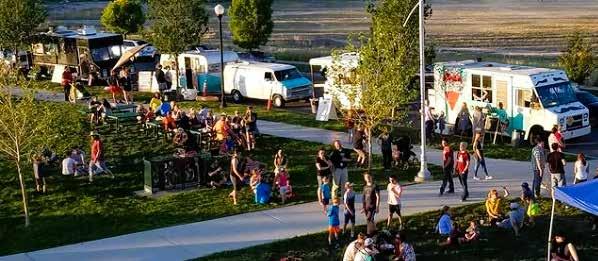
Since its first event in May 2015, the Food Truck League has grown to include more than 250 food trucks, serving thousands of people across Utah each year. (Courtesy of the Food Truck League)
Internet Essentials connects Utah communities
Comcast’s digital program offers low-cost, high-speed internet access.
By Peri Kinder peri.k@thecityjournals.com
Studentsare heading back to school and reliable internet access is more important than ever. Digital connection is necessary for online learning, enabling connection and collaboration for kids and parents alike. With Comcast Internet Essentials, it’s easy to have the access needed for school, work or staying in touch with friends and family.
Internet Essentials provides affordable, high-speed internet access to eligible households at $14.95 each month. This low-cost option, with speeds up to 75 Mbps, is designed for everyday use that includes online meetings, video calling, digital workshops and more. For those who need higher speeds, Internet Essentials Plus offers up to 100 Mbps for $29.95 per month.
“This program has connected more than 234,000 Utahns to a fast, reliable internet connection,” said Deneiva Knight, External

Comcast’s Internet Essentials program allows lower-income households to access high-speed internet and purchase low-cost devices. (Photo courtesy of Comcast)
Affairs Director, Comcast Mountain West Region. “In addition to affordable internet and devices, Internet Essentials customers also gain access to free digital skills training and access to millions of free Xfinity WiFi hotspots across the country, including more than 356,000 in Utah.”

Internet Essentials customers can also purchase a low-cost Dell laptop or Chromebook for $149.99, plus tax. Each device has the hardware and software needed to get online right away, which makes it ideal for students, remote workers, or anyone needing a dependable device at home.
To qualify for the Internet Essentials program, customers must participate in qualifying assistance programs, including housing assistance, Medicaid or SNAP. Applicants cannot be an existing Xfinity customer (within the last 90 days) and can have no outstanding balance with Comcast. To learn more, check eligibility or sign up, visit internetessentials.com or call 1-855-846-8376.
Internet Essentials is part of Comcast’s $1 billion initiative to connect people to the internet, create digital opportunity and build a future of possibilities. By expanding internet access and offering digital skills training, Comcast hopes to provide opportunities to people of all ages and income levels.
“For more than a decade, Comcast has stepped up to ensure everyone can stay connected to what matters most,” Knight said. “We believe everyone should be able to connect to the power of home internet. Whether in rural communities or urban centers, we are working to make the internet accessible to all.” l
Intermountain chefs to compete in national culinary competition
They are one of five finalist teams for the Aug. 21-23 competition in New Orleans.
Two executive chefs from Intermountain Health have been named as one of five finalist teams in the U.S. to qualify for a national culinary competition of healthcare and senior dining chefs hosted by the Association for Healthcare Food Services (AHF) and held in New Orleans Aug. 21-23.
The annual competition highlights the best chefs in healthcare and senior dining facilities who are re-defining the industry with their self-operated culinary services that design and create their meals inhouse rather than contracting with a food service company.
Intermountain Health’s Executive Chef Roberto Rodriguez, based in Salt Lake City, and Executive Chef Joseph Westley, based near Denver, will represent Intermountain Health during the live competition.
Finalist teams were selected from a record-breaking number of submissions across the country through a blind review process and were evaluated by industry leaders using a standardized scoring rubric based on the official competition rules. Criteria include strict adherence to nutritional and cost guidelines, as well as recipe quality, technical skill and culinary innovation.
To qualify, each team selected ingre -
dients from two curated market baskets
tious dish that costs less than $2 and has reduced sodium, fat and calorie levels. The goal is to impress the judges with not

Sweet Potato Mash, Eggplant Dirty Rice with Red Bean Sauce and Remoulade Sauce, topped with an Okra Relish.
“My inspiration for the dish was my previous trips to New Orleans, one of my favorite cities in the world,” said chef Rodriguez. “I wanted to put as much of the heart of New Orleans cuisine on one plate as possible. I tried to incorporate different components of the traditional dishes the area is known for such as red beans and rice, dirty rice and crab cakes.”
“To bring the dish to life, we used a variety of classic cooking techniques including sautéing, boiling, pan-searing, puréeing and emulsifying,” he added.
“This dish will not only make you excited, but it will also make your taste buds excited,” said chef Westley. “The

competition is done in pairs because two sets of hands are better than one in the kitchen. This allows chefs to divide up the workload so we can focus on quality and sanitation.”
The two chefs came together in
Utah recently to practice their dishes. The details of the recipes will be available from Intermountain Health and AHF after the competition in August. l
tain executive chefs includes recipes for Pan-fried Andouille Crab Cakes, Pecan
Intermountain Health’s Executive Chef Roberto Rodriguez, based in Salt Lake City, and Executive Chef Joseph Westley, based near Denver, will represent Intermountain Health during the live competition. (Photo courtesy Intermountain Health)
Reliable internet access is necessary for people of all ages. Whether it’s for school or work, Internet Essentials helps users stay connected. (Photo courtesy of Comcast)
The dish prepared by the Intermountain executive chefs includes recipes for Pan-fried Andouille Crab Cakes, Pecan Sweet Potato Mash, Eggplant Dirty Rice with Red Bean Sauce and Remoulade Sauce, topped with an Okra Relish. (Photo courtesy Intermountain Health)
Bridging the gap: Making farm-to-fork products affordable
Misconceptions about the cost of locally-produced food keep some families from enjoying the benefits.
By Peri Kinder peri.k@thecityjournals.com
Local farmers markets are welcome events, recognized for delivering fresh, seasonal produce and food items. But for some families, the price of farm-fresh products seems to be too high, creating a nutritional divide for lower-income households.
Natalie Loots wants to change that narrative. She is the Community Food Security Program manager with the Utah Department of Health and Human Services and said there are several programs available to make farmers markets accessible and affordable.
“Our main goal is to make local foods, like fruits and vegetables and other high-nutrition foods more affordable for low-income folks,” Loots said. “Our main program that we operate is called the Double Up Food Bucks program, which has been around since 2015.”
With Double Up Food Bucks, people enrolled in the SNAP program can get up to $20 of free Utah-grown produce with every visit to a participating market. The program offers a dollar-for-dollar match, up to $20, matching SNAP benefits.
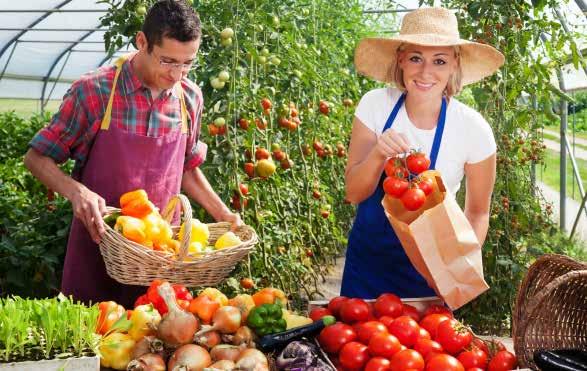
“If folks go to the information booth at the farmers market, they swipe their SNAP card and they’ll get tokens for SNAP and then tokens for Double Up to use at the different vendors at the market. There’s no paperwork they need to fill out. All they have to do is have a valid SNAP card that is currently active.”
Loots said the CFSP works to eliminate barriers that limit access to nutritionally-dense foods. Initiatives like the Senior
Farmers Market Nutrition Program offers low-income seniors a $50 farmers market voucher to use throughout the season. Utah Produce Rx partners with local healthcare clinics to create a $300 fruit and vegetable prescription patients can use at participating farmers markets.
Caroline Hargraves serves as the marketing director for the Utah Department of Agriculture and Food’s economic development division. She said while prices might
be higher on some items at farmers markets, the food quality and nutritional value is much better than what can be found in many grocery stores.
“I think a lot of people don’t understand that it takes time, energy and labor to produce food. We have such a culture in America of expecting food to be cheap but people who produce it deserve a living wage,” Hargraves said. “Farmers get such a small portion of the dollar that the average consumer pays at the grocery store and I think people don’t understand that. But when you buy directly from farmers at a farmers market, that money is going directly to them.”
Utah’s DHHS operates a local food purchasing assistance program to help socially disadvantaged farm owners. Since the spring of 2022, the program has purchased food from local farmers to distribute to families experiencing food insecurity.
More than 60,000 individuals have received farm fresh food at nearly 600 distribution events across the state. This will be the last summer the program will be utilized, as federal funding has been cut, but organizers are looking for additional funding sources.






















A 2025 Utah State University study, Cultivating Community and Commerce: A Summary of the Statewide Social and Economic Impacts of Utah Farmers Markets, found that farmers markets offer more than just fresh produce. Communities hosting farmers markets fostered community connection, empowered small businesses and contributed to the state’s economy.
The study also found food deserts are prevalent in the state. These areas have limited access to nutritious food, affecting more than 800,000 Utah residents. Farmers markets address this dire need, so affordability is key.
“We have several initiatives at the Department of Agriculture and Food to encourage people to support local farmers and ranchers,” Hargraves said. “It does make a difference, both for that individual, like a farmer or business owner, and for the community. The more dollars we can keep circulating in our local economy, the better. But also it tastes better. With local foods, you can taste the difference.”


For more information about farmers markets affordability programs, or to find participating markets, visit uah.org/get-help.
“Our work is aiming to make food security accessible in a way that it functions as a social determinant of health,” Loots said. “Farmers markets are for everybody, and we try to make eating local produce accessible to everybody…Access to healthy foods affects chronic disease outcomes or health outcomes, longevity and quality of life. Those are so deeply connected.” l
Locally produced food has better health benefits and can be more affordable than people realize. (Canva stock)
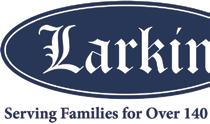

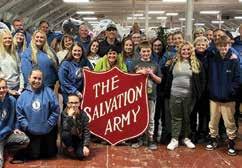



Larkin Mortuary’s dedication to the Utah community is deeply rooted in its history and family values. For over 140 years, spanning seven generations, the Larkin family has proudly served Utah families in their time of need. This commitment extends beyond providing funeral services; Larkin Mortuary actively engages with the community by hosting events and giving back through various service initiatives such as the annual Memorial Day Program, golf tournament, Trunk or Treat and Live Nativity.

By Becky Ginos becky.g@thecityjournals.com
It’s been 65 years since Max Elliott started his career in the Davis County Surveyor’s Office and he’s still going strong. Elliott was just reelected as Davis County Surveyor for another three years – so retirement is in the distance.
“Surveying is kind of a unique line of work,” said Elliott. “You’re more outside than inside.”
It was more or less luck that brought him into the field, he said. “I worked under Don Davis then worked under Glenn Austin. When he retired I served the remainder of his term.”
Elliott served as the elected surveyor for eight terms and in 2021 started his ninth term. During that time he had only one challenger for his position.
“If there was an election and they found out he was running nobody was willing to run against him,” said Administrative Secretary Louise Miller. “Everybody respects him. He knows everything about Davis County. If you ask a question he’ll know where to find the material.”
Max is wonderful to work for, she said. “He lets us do our job but he’s there if needed. I’ll be working on something and he'll ask if I need to sit down or suggest I need time off. He cares about us.”
He treats everyone with respect and kind-
Community
ness, Miller said. “If the public comes in and needs something he’ll give the answer but if he doesn’t know the answer he’ll search until he finds it.”
“I have known and worked with Max for many years,” said Chief Deputy Surveyor, Kyle M. Corbridge. “One day we were surveying in an open field and we were using a 300 foot metal chain to measure distances with. Max took the front end of this metal tape and I held onto the rear end of the chain.”
Corbridge said Max went out about 295 feet from him to set a point in the ground. “I was standing next to an electrical fence the farmer had to keep his livestock in. I was holding onto the reel of this tape secured onto a wooden handle. I somehow ‘accidentally’ made contact with this fence and about 300 feet away I heard a commotion. It took some time before he was able to laugh about that.”
“I’ve seen a lot of changes in 65 years,” said Elliott. “I used to work with steel tapes that were 300 feet long. Now we’ve got global system positioning. It can tell within a dime in an area if it’s done right.”
There’s satisfaction in keeping the real map (which is the earth itself) in place, said Elliott. “It’s quite a job keeping those points in place with all of the growth.”
Elliott said surveyors are concerned that in a few years there won’t be enough people interested in the field to follow in their footsteps.

“Most surveyors are in their 50s, 60s or 70s. I know if they got involved in doing it they’d be excited to come into the profession. I don’t think you can meet anyone who would say they don’t enjoy it.”




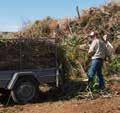
“I thoroughly enjoy this profession,” said Elliott. “I got into it and stayed.” l
“I know him as a man of integrity,” said Corbridge. “As a surveyor he is thorough, ensuring the work is being done in an accurate and precise manner. He has been a great leader, teacher and mentor through his examples and patience.”
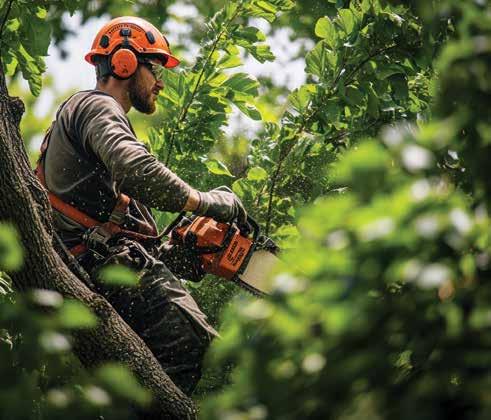
Max Elliott stands on Frary Peak. Elliott has three more years in his term as Davis County Surveyor (Courtesy photo)
















County? City? What’s the difference?
Have you ever wondered what Salt Lake County actually does? If you live in one of the 23 cities in our area—like Murray, West Valley, South Jordan or Millcreek—you might think the county doesn’t affect your daily life. But the truth is, Salt Lake County helps all of us in big and important ways. Everyone who lives in the Salt Lake Valley is part of Salt Lake County.
Salt Lake County is like the glue that holds many parts of our community together. While cities take care of things like neighborhood parks and snow plowing on local streets, the county provides services that work best when shared by everyone. These regional services save money and help us all live better.
What Services Does Salt Lake County Provide?
Let’s break it down. Salt Lake County helps in areas like:
- Public Safety and Criminal Justice: The county runs the jail, provides prosecutors and public defenders, and helps with emergency response. In fact, public safety is the county’s biggest responsibility—it makes up over 74% of the county’s general fund.
- Elections: The county clerk makes

Aimee Winder Newton
Salt Lake County Councilmember| District 3

sure elections are fair and secure. Cities contract with the county clerk for their municipal elections.
- Health Department: The county helps keep our community healthy by inspecting restaurants, giving vaccines, and cleaning up unsafe places like abandoned camps.
- Senior Services: Through programs like Meals on Wheels and senior centers, the county helps older adults stay active and connected.
- Mental Health and Addiction: The county leads programs for people who need support with mental illness or substance abuse, partnering with other groups to reach more people.
- Libraries: The Salt Lake County Library system serves most of the area (Mur-
ray and Salt Lake City have their own), giving people access to books, computers and classes.
- Parks and Recreation: From big parks and trails to swimming pools and rec centers, the county helps families stay active both indoors and outdoors.
- Arts and Tourism: The county owns facilities like Abravanel Hall and the Capitol Theatre, and brings in out-of-state visitors through conventions and tourism, which boosts our economy. The county owns the Salt Palace and Mountain America Expo Center.
- Property Tax and Land Records: The county collects property taxes (even for cities and schools) and keeps track of land ownership and real estate records.
A Government That’s Smart With Your Money
Salt Lake County has a budget of about $2 billion. While that sounds like a lot, only part of it is under the County Council’s full control. About $500 million of the total budget is what we call “passthrough” taxes—meaning the county collects it and passes it to others, like UTA or cities.
To stay financially strong, the Salt Lake County Council keeps a close eye on
spending. They’ve helped the county keep a AAA bond rating—the highest possible score, showing the county is careful with its money. The council also does stress tests and checks each department regularly to look for savings and to improve services.
Utah law doesn’t let counties collect more money just because home values rise. Instead, counties can only collect more if there’s new growth, like a new building. That keeps taxes fair, but it also means the council has to plan ahead and budget wisely.
One County. Many Communities. One Mission.
Salt Lake County doesn’t replace cities—it supports them. Whether your city needs help with road signs, snow removal or mapping, the county can step in with expertise and resources. It’s about teamwork.
The county’s job is to serve, support and strengthen every community in the region. By managing big services, using your tax dollars wisely, and working across city borders, Salt Lake County makes life better for all of us.
So next time you vote, enjoy a park, visit the library, or call for help—remember, Salt Lake County is there for you. l


August is National Self Awareness Month




























There was no “gentle parenting” in the ’70s, especially at the dinner table. You either ate what was prepared for you, or you were labeled a sniveling, spoiled brat who didn’t care if children in China starved because you wouldn’t eat your meatloaf.
One time, I was forced to stay at the table until I’d eaten all my potatoes. I blame my dad. He had told me that potatoes have eyes and then lost his mind when I refused to eat mashed potatoes. I was convinced the lumps were eyeballs and I was not about to eat potato eyeballs.
I wasn’t trying to be picky, I just didn’t like things that were mushy, smelly, runny, squishy, eggy or slathered in mayo.
Grandma Stewart considered me the most coddled child in history. She could not fathom how I could reject her slimy bowl of lima beans, which included (if memory serves) onions, ham, shampoo and arsenic.
“If you don’t eat your lima beans, it just means you're spoiled,” she huffed when I put my head on the table to cry. She said the same thing when I refused to eat bread crust, cottage cheese, tuna fish or canned beets.
Side note: Grandma loved Jordan almonds, the only food she refused to share. She’d hide them from the grandkids because she knew we’d eat them. We scoured the cabinets until we found them and devoured every last one. I think that’s called a self-ful-
Foods that ruined my childhood
Peri Kinder Life and Laughter

filling prophecy, Grandma.
As a kid, terrible food was everywhere. If I wasn’t being subjected to a disgusting recipe Mom found in a McCall’s magazine, I was being betrayed by school lunch ladies. They’d slide a quivering square of delicious cherry Jell-O, topped with whipped cream, onto my lunch tray. But the joke was on me when I took a big bite of the tasty dessert only to learn it was sour cream, not whipped cream. Who does that to a child? Sadists, that’s who!
While eating dinner at a friend’s house, her mom shamed me for not eating the disgusting canned peas. So, I ate it and cried. It was just another meal I was forced to eat, like a hostage.
Sometimes, I’d take a proactive approach when it came to avoiding foods I didn’t like. Mom often made chicken pockets, which were shredded chicken mixed with cream cheese, baked into crescent roll dough. I hated cream cheese (mushy,

smelly). When I saw it in the fridge, I cried. I hid the box of cream cheese behind the wilted lettuce in the vegetable bin, but Mom always found it.
Other ploys included acting sick (rarely worked), “forgetting” about dinner while playing outside (never worked), pretending to sleep on the couch (sometimes worked) and throwing a fit at the dinner table (never worked, plus I lost dessert).
I don’t know why Mom refused to accommodate my delicate palate. I was only repulsed when it came to sauces, dressings, mustard, canned foods, Vienna sausages, tuna, cottage cheese, sour cream, maple syr-
up, vegetables, macaroni salad, yogurt, the textured vegetable protein popular in the ’70s or anything slathered in mayo. It didn’t matter. I was expected to “Learn to like it, or else!” Or else, what? A grateful digestive system? A lack of nightmares? A healthy relationship to food? With four daughters, I understand how hard it is to make meals for ungrateful children. I’ve had daughters who refused to eat pizza, spaghetti, meat, dairy products, lasagna, hamburger casserole or anything with onions. They probably have their own list of foods that ruined their childhood. That’s what therapists are for. l Midvale



































